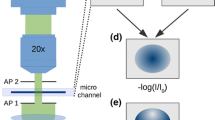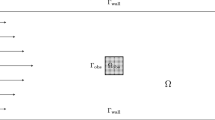Abstract
The rigorous optimization of the geometry of a glass cell with computational fluid dynamics (CFD) is performed. The cell will be used for non-invasive nuclear magnetic resonance (NMR) measurements on a single droplet levitated in a counter current of liquid in a conical tube. The objective function of the optimization describes the stability of the droplet position required for long-period NMR measurements.
The direct problem and even more the optimization problem require an efficient method to handle the high numerical complexity implied. Here, the flow equations are solved two-dimensionally and in steady state with the finite-element code SEPRAN for a spherical droplet with ideally mobile interface. The optimization is performed by embedding the CFD solver SEPRAN in the optimization environment EFCOSS. The underlying derivatives are computed using the automatic differentiation software ADIFOR. An overall concept for the optimization process is developed, requiring a robust scheme for the discretization of the geometries as well as a model for horizontal stability in the axially symmetric case. The numerical results show that the previously employed measuring cell described by Schröter is less suitable to maintain a stable droplet position than the new cell.
Similar content being viewed by others
References
Anderson WK, Newman JC, Whitfield DL, Nielsen EJ (2001) Sensitivity analysis for the Navier–Stokes equations on unstructured meshes using complex variables. AIAA J 39(1):56–63
Berz M, Bischof CH, Corliss G, Griewank A (1996) Computational differentiation: techniques, applications and tools. SIAM, Philadelphia
Bischof CH, Carle A, Khademi P, Mauer A (1996) ADIFOR 2.0: automatic differentiation of FORTRAN 77 programs. IEEE Comput Sci Eng 3(3):18–32
Bischof CH, Bücker HM, Lang B, Rasch A (2003a) An interactive environment for supporting the transition from simulation to optimization. Sci Program 11(4):263–272
Bischof CH, Bücker HM, Lang B, Rasch A (2003b) Solving large-scale optimization problems with EFCOSS. Adv Eng Softw 34(10):633–639
Bischof CH, Bücker HM, Rasch A, Slusanschi E (2003c) Evaluation of a computer model for wavy falling films using EFCOSS. In: Kumar V, Gavrilova ML, Tan CJK, L’Ecuyer P (eds) Computational science and its applications—ICCSA 2003, proceedings of the international conference on computational science and its applications, part II, Montreal, Canada, 18–21 May 2003. Lecture notes in computer science, vol 2668. Springer, Berlin, pp 78–84
Bischof CH, Bücker HM, Rasch A, Slusanschi E (2003d) Sensitivities for a single drop simulation. In: Sloot PMA, Abramson D, Bogdanov AV, Dongarra JJ, Zomaya AY, Gorbachev YE (eds) Computational science—ICCS 2003, proceedings of the international conference on computational science, part II, Melbourne, Australia and St. Petersburg, Russia, 2–4 June 2003. Lecture notes in computer science, vol 2658. Springer, Berlin, pp 888–896
Bischof CH, Bücker HM, Lang B, Rasch A, Risch JW (2003e) Extending the functionality of the general-purpose finite element package SEPRAN by automatic differentiation. Int J Numer Methods Eng 58(14):2225–2238
Bischof CH, Bücker HM, Lang B, Rasch A, Slusanschi E (2005) Efficient and accurate derivatives for a software process chain in airfoil shape optimization. Future Gener Comput Syst 21(8):1333–1344
Bosch EGT, Lasance CJM (2000) High accuracy thermal interface resistance measurement using a transient method. Electron Cool Mag 6(3):26–32
Brauer H (1979) Turbulenz in mehrphasigen Strömungen. Chem Ing Tech 51(10):934–948
Bücker HM, Corliss GF, Hovland PD, Naumann U, Norris B (2005) Automatic differentiation: applications, theory, and implementations. Springer, New York
Carle A, Fagan M, Green LL (1998) Preliminary results from the application of automated adjoint code generation to CFL3D. In: Proceedings of the 7th AIAA/USAF/NASA/ISSMO symposium on multidisciplinary analysis and optimization, St. Louis, MO, USA, 2–4 September 1998, AIAA Paper 98-4807
Clift R, Grace JR, Weber ME (1978) Bubbles, drops, and particles. Academic Press, New York
Corliss G, Faure C, Griewank A, Hascöet L, Naumann U (eds) (2002) Automatic differentiation of algorithms: from simulation to optimization. Springer, New York
Gay DM (1990) Usage summary for selected optimization routines. Computing Science Technical Report 153, AT&T Bell Laboratories, Murray Hill
Griewank A (1989) On automatic differentiation. In: Iri IM, Tanabe K (eds) Mathematical programming: recent developments and applications. Kluwer Academic, Dordrecht, pp 83–108
Griewank A (2000) Evaluating derivatives: principles and techniques of algorithmic differentiation. SIAM, Philadelphia
Griewank A, Corliss G (1991) Automatic differentiation of algorithms. SIAM, Philadelphia
Han SI (2001) Correlation of position and motion by NMR: pipe flow, falling drop, and salt water ice. Dissertation, RWTH Aachen University
Han SI, Stapf S, Blümich B (2001) NMR imaging of falling water drops. Phys Rev Lett 87(14):144501
Hascoët L, Vazquez M, Dervieux A (2003) Automatic differentiation for optimum design, Applied to sonic boom reduction. In: Kumar V, Gavrilova ML, Tan CJK, L’Ecuyer P (eds) Computational science and its applications—ICCSA 2003, proceedings of the international conference on computational science and its applications, part II, Montreal, Canada, 18–21 May 2003. Lecture notes in computer science, vol 2668. Springer, Berlin, pp 85–94
Henschke M (2004) Auslegung pulsierter Siebboden-Extraktionskolonnen. Shaker Aachen, Habilitationsschrift, RWTH Aachen, ISBN 3-8322-3511-6.
Henschke M, Pfennig A (1996) Simulation of packed extraction columns with the REDROP model. In: Proceedings of the 12th international congress of chemical and process engineering, CHISA, Praha
Henschke M, Waheed A, Pfennig A (2000) Wandeinfluss auf die Sedimentationsgeschwindigkeit von Kugeln. Chem Ing Tech 72(11):1376–1380
Idelchik IE (1994) Handbook of hydraulic resistance. CRC Press, Boca Raton, pp 239–331
Kumar A, Hartland S (1994) Prediction of drop size, dispersed-phase holdup, slip velocity, and limiting throughputs in packed extraction columns. Trans IChemE, Part A 72:89–104
Lyness JN, Moler CB (1967) Numerical differentiation of analytical functions. SIAM J Numer Anal 4:202–210
Martins JRRA, Sturdza P, Alonso JJ (2003) The complex-step derivative approximation. ACM Trans Math Softw 29:245–262
Schröter J, Bäcker W, Hampe MJ (1998) Stoffaustauschmessungen an Einzeltropfen und an Tropfenschwärmen in einer Gegenstrommeßzelle. Chem Ing Tech 70(3):279–283
Rall LB (1981) Automatic differentiation: techniques and applications. Lecture notes in computer science, vol 120. Springer, Berlin
Segal G (1993) SEPRAN users manual. Ingenieursbureau Sepra, Leidschendam
Segal G, Vuik C, Vermolen FA (1998) Conserving discretization for the free boundary in a two-dimensional Stefan problem. J Comput Phys 141(1):1–21
Slattery JC (1990) Interfacial transport phenomena. Springer, Berlin
Tabata M, Itakura K (1998) A precise computation of drag coefficients of a sphere. Int J Comput Fluid Dyn 9(3–4):303–311
Tomiyama A, Tamai H, Zun I, Hosokawa S (2002) Transverse migration of single bubbles in simple shear flows. Chem Eng Sci 57:1849–1858
van Kan JJIM, Segal A (1995) Numerik partieller Differentialgleichungen für Ingenieure. Teubner, Stuttgart, p 117
van Keken PE, Yuen DA, Petzold LR (1995) DASPK: a new high order and adaptive time-integration technique with applications to mantle convection with strongly temperature- and pressure-dependent rheology. Geophys Astrophys Fluid Dyn 80:57–74
Author information
Authors and Affiliations
Corresponding author
Rights and permissions
About this article
Cite this article
Groß-Hardt, E., Slusanschi, E., Bücker, H.M. et al. Practical shape optimization of a levitation device for single droplets. Optim Eng 9, 179–199 (2008). https://doi.org/10.1007/s11081-007-9027-x
Received:
Accepted:
Published:
Issue Date:
DOI: https://doi.org/10.1007/s11081-007-9027-x




